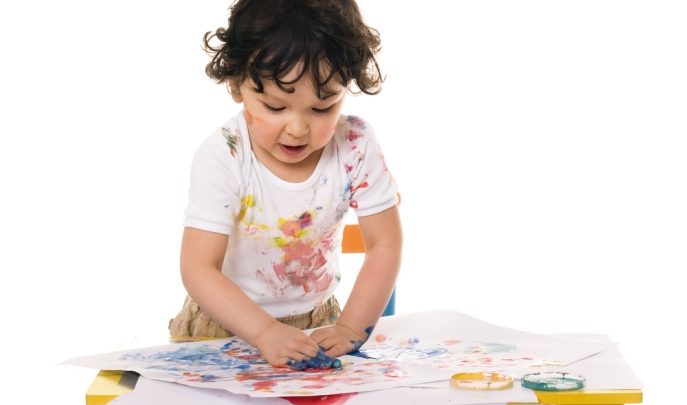Getting Messy With…Paint

Combine paint with messy play and you’ll create and enhance a host of learning opportunities, says Kirstine Beeley…

What does paint in early years mean to you? Brushes, easels and multiple copies of Van Gogh’s ‘Sunflowers’ adorning a perfect display – or children up to their necks in a unique and exciting medium, which allows them to access all that that we could ever want from messy play?
More than just a resource for expressive and creative arts, paint can provide a host of sensory and manipulative experiences, plus lots of chances to build on understanding of materials and other early science knowledge. By looking at some of these aspects individually I hope to give you some ideas and boost your enthusiasm for making messy paint play a staple of your setting’s planning.
Stimulating the senses
We learn by stimulating all five of our senses. With each new experience we are building on existing brain connections and developing our potential for future learning. Messy play helps to stimulate children’s senses as part of their ongoing exploration. It offers chances to explore wide ranging materials and the textures, smells and consistencies that they bring, but also a chance to explore with hands, feet and whole bodies – a truly complete sensory experience.
Smell By adding sensory elements to paint, children can experience a wide range of smells both as they paint and as they explore paint with their fingers, toes and noses. Add food essences such as vanilla, peppermint, orange, lemon and almond (don’t use essential oils as these can cause skin reactions and can be dangerous to pregnant practitioners). Why not add chopped up herbs and petals from your garden? Mint, basil, lemon balm and curry plants all offer great smells, as do rose petals and lavender.
Exploring a tray of purple paint scented with lavender heads can give rise to amazing discussion and language as well as stimulating the senses. And who says you have to paint with paint? Mix up powdered spices such as cinnamon, paprika, cumin and all spice with a little water and have a go at painting with them. Just be careful not to use spices such as chilli powder which can irritate skin and eyes.
Touch Messy play gives children an unprecedented opportunity to explore materials with hands, feet and bodies; by allowing them to physically get into paint they get lots of chances to explore textures and build their understanding of touch.
In summer, why not try setting up a paddling pool outside and let children climb in? If you’re not feeling that brave, paint onto body parts such as arms and legs; it’s a sensory experience which is both unusual and very ticklish, and the washing off with warm soapy water and soft sponges is a sensory experience in itself.
When it’s less hospitable outside, add different materials to paints and let children explore with their hands in a tray – try sand, sawdust, rice, tapioca, cellulose paste (non-fungicidal) or Rice Krispies.
Sight Exploring paint allows children to mix colours and add a variety of materials to them, but it also allows them to experience other visual aspects such as reflections and contrasts. Painting and smearing paint onto foil or mirrored surfaces provides lovely experiences of reflections, as does adding vegetable oil and powder paint to puddles outdoors. Try exploring glow paint (see panel for instructions on how to make your own) too.
Sound When you add paint to materials, or materials to paint, and then add the vital ingredient – children – you can create some amazing sounds and sensory experiences. Pouring paint onto big sheets of bubble wrap and stamping all over it with bare feet, or squishing paint and cereals together with our hands, can produce lovely cracking and popping sounds.
Adding coloured mud paints to crunchy leaves produces even more effects, and what better sound than the splat of painted sponges on plastic sheeting?
Taste Paint is not recommended for eating even if it is marketed as non-toxic, but that doesn’t stop you painting with things which are edible. Try melting chocolate, colouring it with food colours and painting onto greaseproof paper, or painting with food colours directly onto edible rice paper. You could even colour evaporated milk with food colouring and paint onto white bread (stick it in the toaster, cook and eat your paint creations!).
When adding herbs to paint to create smells, why not have a go at tasting too? (Remember to consider food allergies when exploring with food stuffs.)
Manipulating mess!
Paint provides many ways to develop exciting manipulative play experiences. When it is drizzled over sand or wet sawdust, children can squish and squash as they mix up the paints and see the mixture change in both colour and texture. Try giving children instant mashed potato and small squeezy bottles of coloured paint and see what they mix up – maybe a volcano with red lava, or a pond with blue water and green weed…
Even when paint is mixed with cereals or rice, the opportunity to squeeze the mixtures will help build those all important hand and wrist muscles for early writing. Children love the extra sensory element of adding the wet paint to the mix, and it doesn’t stain their hands as much as food colouring!
As has been mentioned, playing with paint offers lots of chances to develop fine motor skills by squishing and squashing with other materials. It also provides opportunities to begin developing coordination through mark making. Try adding frozen cubes of coloured paint to white shaving foam and see what rainbow marks children can make as the cubes are moved around and start to melt. Squirt poster paint onto a table covered in tin foil and move it around with fingers to make mirrored marks.
Using paint as part of a messy play exploration also offers plenty of opportunities to hone those larger muscles and bigger control movements from elbows, shoulder and backs. Try dipping a sock with wet sand in it into some paint and bouncing your sock yo-yo onto a really big piece of paper, or try dipping balls into paint and either bouncing them on large pieces of paper outdoors, or throwing them at a large sheet pegged to a wall or fence.
Mould it, melt it, pour it
Messy paint play is great way to explore materials and their properties as part of children’s emerging science understanding. Adding paint to a mixture of sand and cornflour gives a mouldable mixture, as does paint mixed with tapioca or sawdust. Giving children the chance to squeeze and mould these materials helps them to understand how they can change the shape of things and provides a unique sensory exploration.
Lots of settings will explore the properties of ice, especially in the warmer months of spring and summer, so why not try freezing paint and exploring as it melts? Freeze in ice cube trays and place ice paint cubes at the top of a paper slope outdoors; as the cubes melt and slide down the paper a paint rainbow will appear (children love guessing which of the cubes will race to the bottom first – forces observed first hand!). Or add frozen paint cubes in a wide variety of colours and shapes to your water tray and watch as they melt and the colours mix.
Paint as part of messy play is unique in that it can be mixed to varying thicknesses which all pour differently. Try putting paints into zip-up freezer bags and snipping off a corner. Bingo! You have your very own paint piping bag to let children squeeze out lots of patterns and colours onto paper, or even sand or water.
How about stacking some plastic drinking cups into a pyramid and allowing children to squeeze a mixture of paint and PVA glue over the pyramid from the top? They will love seeing all of the different colours drizzling down, and the more colours you add the more appealing your rainbow covered sculpture looks. The joy of adding glue is that as the paint dries it leaves you with a beautiful, permanent, waterproof sculpture to either display or add to at a later date.
No mess messy play
Not all children cope with or like the sensory experience of materials on their hands or feet. Try to acknowledge this as part of what makes them an individual and not something which needs to be overcome (we adults don’t like everything, so we shouldn’t expect children to!).
This doesn’t mean that they can’t take part in the mark making and squishing that some messy play offers. Try filling a zip-up plastic food bag with paint and shaving foam, and sealing it with clear parcel tape – children can then squish and squash it, making marks and/or forming letters and numbers in the mixture without getting messy at all. You can add glitter or sequins to make it even more appealing, or tiny objects for children to squish and find (it’s a bit like squishing a big marshmallow!).
If you’re feeling a bit more adventurous, squirt paint and shaving foam or hair gel onto a tabletop and cling film the whole table (you will need lots of layers to avoid tears).
Go with the glow
Try this simple recipe to create your own fluorescent paint
You will need… • Yellow and green highlighter pens • Shaving foam • Water • UV black light
1. Carefully remove the inside of the highlighter pen (the spongy bit with the colour in it). Place this into a jar of warm water and leave to soak for a few hours (or squeeze out the colour with your hands if you’re strapped for time). You have now created glow water! Add this to your water tray for glow in the dark water play fun!
2.Pour a bit of the glow water into a bowl and add some shaving foam, mix until you have a coloured foam paste. This is your glow paint. Make up other colours using different highlighter pens (you can purchase glow-in-the-dark paints online which can be watered down for this activity).
3. Using a UV black light (available for about £5 on good online auction sites) create your dark area and explore with painting with your glow paints either onto paper on into a shallow tray for mixing with fingers.
Kirstine Beeley is an author and educational consultant; for more information, visit www.playingtolearnuk.com












